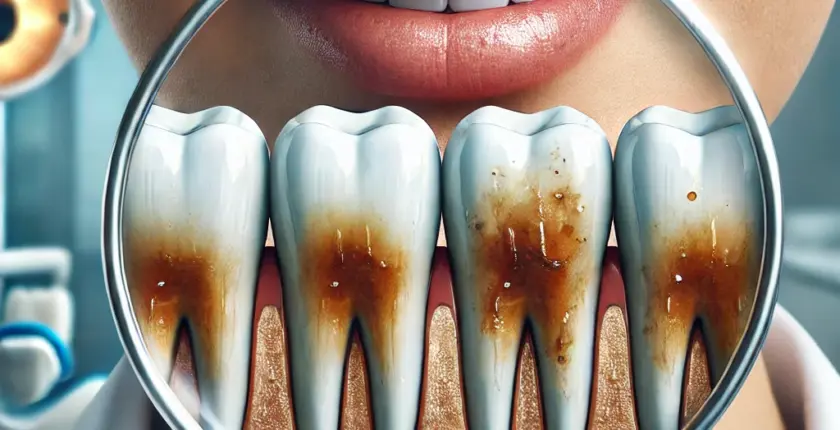Library
Fluorosis Uncovered: Identifying and Understanding Enamel Damage: Response to the Medical Image Challenge
- February 25, 2025
- Posted by: Namrata Chhabra
- Category: Learning resources Case studies Clinical Case discussions Image Challenge Library Minerals Vitamins and Minerals

Exploring the Causes and Consequences of Fluorosis
This post provides a detailed explanation and diagnosis for the medical image challenge we previously posted. If you haven’t seen the challenge yet, refer to our previous post for the case details here before reading the full response.
Case Presentation
A 12-year-old child is brought to the dental clinic by their parents due to concerns about progressive discoloration of teeth. The parents report that the child’s permanent teeth have developed brown stains over the past few years. They recently moved from a rural area where the primary water source was a local well. The child denies any pain but reports that some teeth feel rough and brittle. A dental examination reveals patchy enamel discoloration, surface pitting, and signs of brittleness.
What is your diagnosis?
Diagnosis & Explanation
Diagnosis: Dental Fluorosis
Dental fluorosis is caused by excessive fluoride intake during tooth development, leading to hypomineralization of enamel. It typically presents as white streaks in mild cases and brown stains with enamel pitting in severe cases.
Reason Behind Fluoride Deposition
Fluoride is deposited in hydroxyapatite crystals of teeth and bones, forming fluorapatite, which is more resistant to acid dissolution than hydroxyapatite. However, excess fluoride interferes with normal ameloblast function, leading to enamel hypomineralization and porosity, which causes fluorosis.
Functions of Fluoride in Normal Health
1️. Prevents Dental Caries: Fluoride strengthens enamel and makes teeth more resistant to acid attacks from bacteria.
2️.Enhances Bone Health: Fluoride increases bone mineral density but excessive amounts may cause skeletal fluorosis.
3️. Affects Enzyme Activity: Fluoride interacts with several enzymes, influencing metabolic pathways.
Causes & Implications of Fluorosis
Causes:
- Excess fluoride in drinking water (common in certain geographic areas)
- Fluoride-rich foods or supplements
- Use of fluoride-containing toothpaste in young children who swallow it
Implications:
- Dental fluorosis (aesthetic concerns and enamel weakness)
- Skeletal fluorosis (joint pain, stiffness, and brittle bones in severe cases)
- Neurological effects (excess fluoride exposure has been linked to cognitive effects in children)
Prevention of Fluorosis
- Optimal Fluoride Intake: Monitoring and regulating fluoride exposure in drinking water.
- Use of Fluoride-Free Toothpaste: Especially in children under 6 years of age who may swallow it.
- Public Health Measures: Defluoridation techniques for water in endemic areas.
Fluoride’s Role in Glycolysis Inhibition & Sample Collection
- Fluoride as a Glycolysis Inhibitor: Fluoride inhibits enolase, a key enzyme in glycolysis, preventing glucose breakdown into pyruvate. This mechanism is used in blood sample preservation to prevent glucose degradation after sample collection.
- Fluoride in Sample Collection: Sodium fluoride (NaF) is commonly used in blood collection tubes for glucose estimation. It inhibits glycolysis in the sample, preventing false low glucose readings.
Did You Know?
Ameloblasts are specialized cells responsible for forming enamel, the hardest substance in the human body. They secrete enamel matrix proteins like amelogenin and enamelin, facilitating enamel mineralization. Ameloblasts play a key role in:
🔹 Regulating calcium and phosphate deposition in enamel.
🔹 pH buffering during enamel formation to ensure proper mineralization.
🔹 Enamel maturation, removing water and proteins to harden the structure.
🔹 Preventing tooth decay, as healthy enamel is highly resistant to acid.
However, in fluorosis, excess fluoride disrupts ameloblast function, leading to enamel hypomineralization, porosity, and discoloration. Since ameloblasts disappear after tooth development, damaged enamel cannot regenerate, making prevention critical!
Think you know the answer? Drop your diagnosis and reasoning in the comments!
